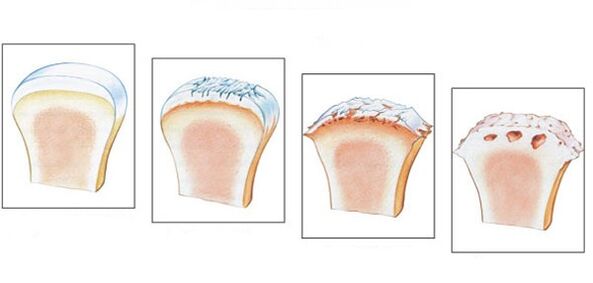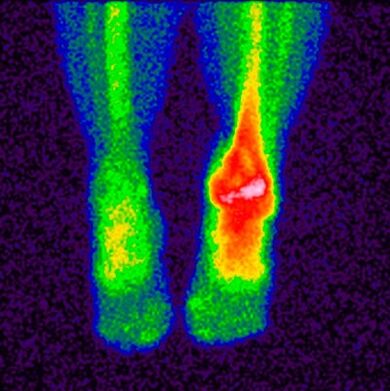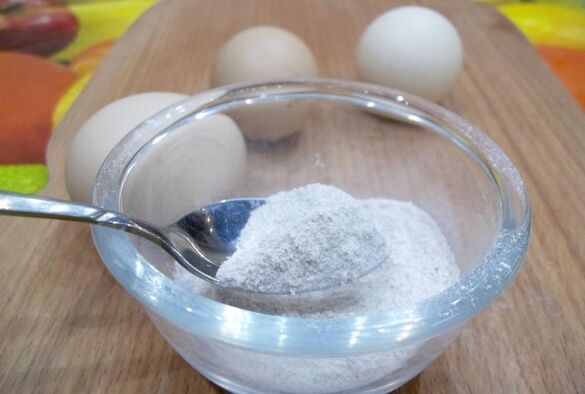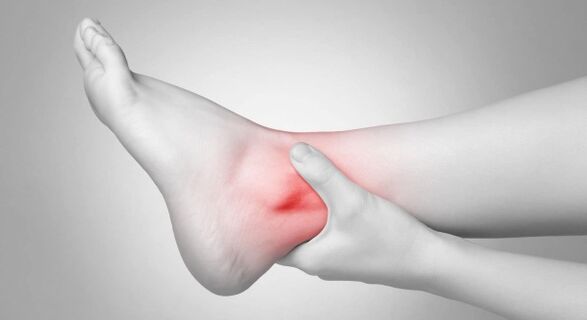The ankle joint is often injured because it is subjected to heavy loads. A doctor can diagnose ankle arthrosis based on symptoms and prescribe treatment. The disease does not depend on age and sex, tissues become thinner and destroyed, which can lead to disability.
Arthrosis affects 12% of the population, and more often the disease affects women of retirement age.
As mentioned, the ankle can withstand a large load. It keeps the body upright and allows the person to move. Its violation changes the usual way of life.
Arthrosis of the ankle joint (symptoms and treatment may be different) is a chronic disease in which irreversible processes occur in the cartilage.
The disease occurs gradually. A healthy person has a smooth articular surface. When overloaded, it facilitates slipping during physical activity.
With arthrosis, tissue nutrition and metabolism deteriorate. The outer surface of the joint changes, becomes rough, touches the cartilage, inflammation appears. When a person lifts heavy objects, the load falls on the bone, which causes degenerative disorders.
If treatment is not started, severe pathologies develop. In the later stages, the cartilage and tissue are affected, the synovial membrane is irritated, and the joint loses its stability. In this case, the supporting function suffers, movements become difficult.
Species
There are several types of arthrosis depending on different criteria:
- causes of occurrence (primary, secondary);
- stages of arthrosis;
- localization of pathology;
- forms of localization (generalized and local);
- the course of the disease (acute and chronic).
| Classification criteria | Types of arthrosis |
|---|---|
| place of manifestation | knee, wrist, ankle, elbow, shoulder and neck arthrosis. |
| cause of occurrence |
|
| localization |
|
| the course of the disease |
|
Ankle arthrosis is divided into primary (degenerative processes begin in healthy cartilage as a result of excessive physical activity) and secondary (destructive is diagnosed, dystrophic changes in the cartilage tissue appear).
Stages and degrees
Arthrosis of the ankle joint (symptoms and treatment directly depend on the age of the patient) can occur in different ways. For some, many years pass from the onset of the first symptoms to the critical stage, for others, the disease develops rapidly.
The age at which the therapy starts depends on the accompanying diseases. As ankle arthrosis progresses, symptoms become more prominent.
There are 4 stages of the disease.
- The first stage is often overlooked. Main symptoms: stiffness in the morning, a characteristic crisis when walking. Pathogenic changes are not detected in the image, the destructive process has already begun.
- Morning stiffness lasts longer. Leg development will take 20-30 minutes. Some patients have lameness. On the X-ray, you can see stage 2 pathology with bone growth and bone displacement.
- In stage 3, symptoms are more pronounced. Painful sensations appear in a calm state, the patient cannot do without painkillers. Lameness is noticeable and crutches are sometimes necessary. The joint swells, changes, the muscles become thinner and the volume decreases. As can be seen on an X-ray, the joint space narrows and osteophytes are formed.
- The final stage develops in the absence of treatment. Cartilage is destroyed, the surfaces of the joints grow together. The patient cannot walk.
There are several degrees of arthrosis:
- First degree– X-ray shows no change or articulation. There is mild morning stiffness. It is necessary to start treatment at this stage.
- In the second degreeactivity becomes difficult, a creaking sound is heard when walking, swelling is observed. X-ray shows a decrease in the interarticular space. The person limps and the morning stiffness lasts longer.
- In the third degreeclearly expressed crusarthrosis, joint deformation. Muscles become more atrophied, movements are limited. Constant rest is required. The pain does not go away in this case.
- ExtremelyThere is practically no shared space, and activities are almost impossible. X-ray allows to diagnose many osteophytes. Only surgical intervention is prescribed.

Ankle arthrosis appears gradually, so treatment should be started when the first symptoms appear to prevent the condition from worsening and complications.
Symptoms
Osteoarthritis of the ankle joint is characterized by several symptoms (affecting the treatment method):
- The pain is initially moderate and occurs only during physical activity. Over time, the pain intensifies and bothers you at rest;
- with injuries and dislocations, swelling and inflammatory manifestations appear, and the temperature rises in the damaged area;
- "dry" click accompanied by pain;
- dislocation, as the cartilage tissue thins and deteriorates, the joint loses stability. Bones are displaced and fall out of the joint capsule;
- joint stiffness;
- a person gets tired quickly while walking;
- in the final stages, the joint is deformed.

If at least one symptom occurs, you should immediately consult a doctor.
Reasons for appearance
Osteoarthritis of the ankle joint (symptoms and treatment are often caused by age-related changes) affects the older generation. Recently, pathology has been observed among young people.
The precipitating factors are:
- injuries, dislocations and bruises;
- age-related disorders in joints and ligaments;
- inflammatory processes;
- overweight;
- disturbance of metabolic processes;
- congenital foot deformity and flat feet that occur during life;
- hereditary tendency;
- excessive physical activity;
- wearing uncomfortable shoes;
- diseases of the endocrine system;
- osteochondrosis.

Less synovial fluid is produced, which leads to less nutrition of the cartilage. The joint space narrows, which can lead to bone fusion. Crusarthrosis occurs, it cannot be reversed. Nevertheless, immediate treatment should be prescribed to prevent the development of the disease.
Diagnostics
The diagnosis of arthrosis consists of studying the existing symptoms and the information obtained from the research. Because there are no tests that can clearly identify the pathology, doctors do not consider laboratory methods to be effective enough.
During remission, indicators are normal, during relapse, the blood test shows an increase in ESR and c-reactive protein. This means that the pathology has already begun.
Instrumental methods are used to confirm the diagnosis:
- Simpleradiographyis the most reliable method. Muscles do not absorb X-rays equally: soft ones transmit and hard ones absorb. Research reveals the disease itself and its consequences.
The image allows to analyze the position of the bone surfaces in the joint, the shape, size and location of the structures relative to each other, the condition of the tissue and the size of the joint cavity. Thanks to this information, the degree of pathology can be determined.

If the ankle is affected, the diagnosis is made on the lateral, posterior and posterior projections with the foot moving inward. If there are corresponding symptoms (narrowing of the joint space, osteophytes and other signs), arthrosis is diagnosed.
- Nuclear magnetic resonancedetermines the disruption of the activity of hydrogen molecules under the influence of a strong magnetic field. It gives an opportunity to explore parts of the body that contain water.
The darker shade in the image represents bones because they have less water content and muscles, nerves and discs appear lighter. Diagnostics detect even small irregularities in bone tissue and joints. The procedure is shown before joint replacement. The only negative is the high cost of diagnostics.
- Magnetic resonance imagingexamines the ligamentous structure of the joint, muscle tissue and cartilage very precisely. Thanks to the research, a specialist can assess the condition of the joints of the lower leg, which allows to identify the pathology at the very beginning of its development. The procedure is painless and lasts about 30 minutes.
During the procedure, radio waves and strong magnetic rays affect the person. It should be remembered that the magnetic field is dangerous for the physiological state. MRI is prohibited in case of neuropsychiatric disorders, pregnancy and the presence of metal objects in the body.
- Ultrasoundallows for accurate diagnosis. The device produces waves that are reflected from tissues and recorded on a screen. The doctor examines the image and makes a diagnosis. For the clarity of the image, a gel is used that removes air and provides easy movement on the surface.
The advantages of this procedure are health safety, affordable price and high accuracy.
- Bone scintigraphy- a study that allows determining pathological disorders in bones using isotopes. A special substance containing labeled atoms is injected into the patient's body. Pathological areas are divided into cold and warm.
The first one does not have isotopes, the blood flow to them is weaker and is not detected during scanning. This includes places where malignant tumors appear. In hot areas, isotopes accumulate more actively and are clearly detected during scanning. These areas indicate the occurrence of inflammatory processes.
This study makes it possible to distinguish arthrosis from similar diseases with similar clinical symptoms, based on the results, the doctor makes a prognosis and prescribes treatment.
The main contraindications for the study are carrying a child, breastfeeding and taking drugs containing barium.
- Joint punctureis a procedure in which the doctor inserts a needle into the joint cavity to obtain synovial fluid for analysis.
This biomaterial continues to be studied in the future, based on the results, the specialist determines the characteristic features of the disease and at what stage of development it is. For arthrosis of the ankle, a puncture is made in the anterior part between the outer ankle and the tendon of the extensor digitorum longus.

When to consult a doctor
If the treatment of arthrosis is not started on time, loss of working capacity and sometimes disability occurs. Some patients are not in a hurry to seek help because they do not know which doctor to make an appointment with. At the first symptoms, it is necessary to visit a rheumatologist, who diagnoses dystrophic and inflammatory changes in the joint.
You should contact him if:
- after excessive load, at the end of the working day, there is discomfort and pain in the joints;
- it is difficult to find a comfortable position for your legs at night;
- the joints swell, the skin becomes red;
- there is sharp pain, it is difficult to move;
- creaking and clicking sounds appear;
- joints are deformed.
With the help of modern diagnostic and therapeutic methods, it is possible to avoid surgical intervention and preserve the function of the joint.
Prevention
Osteoarthritis of the ankle joint (symptoms and treatment can be checked with a doctor) can be prevented.
To prevent arthrosis, experts recommend following certain rules:
- wear comfortable shoes that fit properly and do not have heels;
- maintain proper nutrition, drink enough clean water;
- choose a suitable vitamin and mineral complex;
- train;
- take more frequent walks in the fresh air;
- avoid excessive stress on the legs;
- avoid hypothermia;
- to be regularly observed by doctors;
- give up bad habits;
- do a series of exercises to warm up the ankle joint.

It is especially important to regulate your diet. Dieticians have agreed on a menu that will prevent the exacerbation of the disease and saturate the body with the necessary substances.
- You need to eat often and in small portions.
- Drink at least 2 liters of clean water.
- Avoid sweet and salty foods.
- Do not eat 4 hours before going to bed.
- Steam, cook, boil food.
Fasting and a strict diet for arthrosis are strictly prohibited in order to prevent the leaching of calcium, which is necessary for the regeneration of bones and cartilage.
Treatment methods
Once the diagnosis is confirmed, treatment should be started immediately. It is impossible to completely get rid of arthrosis, the main thing is to slow down the destructive processes and increase the period of remission. Various techniques are used for this.
Medicines
Different drugs are used to treat arthrosis:
- Anti-inflammatoryand pain relievers remove the source of inflammation and relieve pain. Tablets and ointments are used. The sooner anti-inflammatory drugs are taken, the greater the chance of joint rescue.
- GlucocorticoidsIt is used when the above drugs do not bring the desired result. They are produced in the form of an injection solution and injected into the joint.
- Chondroprotectorsit is necessary to slow down the process of cartilage destruction.
The treatment regimen and the dosage of drugs are drawn up by the doctor based on the severity of the symptoms, accompanying diseases and other factors. In order not to aggravate the situation, self-medication is strictly prohibited.
Traditional methods
As for the traditional methods of treating arthrosis, doctors recognize their beneficial properties and positive effects. Traditional medicine is also used as prevention of diseases.
The main prescriptions for the treatment of ankle arthrosis are as follows:
- Burdock leaves are washed well and applied to the skin with the soft side. The plant is fixed with a bandage or cling film and left overnight.
- Heat sea salt (buckwheat, sand) in a frying pan, pour it on a linen cloth and apply it to the painful area. Keep until the salt cools down. This is an effective way to relieve pain.
- Pour three layers of cologne on the lilac, keep it in a dark place for 2 weeks, rub it twice a day on the painful area.
- Grind eggshell into powder, take 0. 5 tsp. before eating.

The use of traditional treatment methods should be agreed with the attending physician. This is not the only measure, but an addition to the main therapy.
Other methods
When conservative therapy does not have a positive effect, they resort to radical measures - surgery.
As a rule, the instructions for the operation are as follows:
- 3-4 degree recurrent and primary arthrosis;
- complications;
- severe and long-lasting pain radiating to the knee;
- obvious lameness;
- paralysis of leg muscles;
- deterioration of the flexion-extension properties of the joint and the ability to support the leg.
The following surgical interventions are used for foot arthrosis:
- Arthrodesis- surgery to immobilize the joint. Its task is to restore the lost ability to support the limb. The main disadvantage is the possibility of bone fusion, which causes immobility, so it is used very rarely.
- Arthroscopyis a minimally invasive procedure in which the doctor cuts the joint and inserts an arthroscope. The surgeon performs a visual examination and assesses the condition of the intra-articular structures and, if necessary, removes parts of the damaged joint or blood clots from the synovial fluid. The risk of recurrence with this operation is very high.
- Endoprosthesesit is carried out in especially severe cases. It allows you to replace a damaged joint in a certain part or completely. Dentures with modernized mechanics are used and last up to 20 years.
The main contraindications for the operation are age below 12 years, fistulas in the joint, diabetes, heart dysfunction and infectious diseases.
Possible complications
If treatment is delayed or absent, the following complications may occur:
- disability;
- irreversible deformation;
- immobility and immobility of the joint;
- decrease in the quality and level of life.

In addition to these complications, the chronic course of the disease is accompanied by pain, anxiety, inability to lead an active lifestyle.
To make gymnastics, drugs and folk remedies more effective, it is recommended to use special orthopedic means that reduce the joint load. It includes an orthosis and a fixation bandage.
The orthosis completely follows the contours of the ankle, increases the range of motion, relieves swelling and pain. A fixation bandage has the same effect as an orthosis. It is made of soft elastic fabric that allows you to adjust the joint well. The bandage is used only in periods of remission, when the exacerbation has passed.
Osteoarthritis of the ankle joint is a serious disease that leads to serious consequences and complete immobility of the joint if not completely treated. Early diagnosis, attention to symptoms and competent therapy allow to avoid surgical intervention.





































